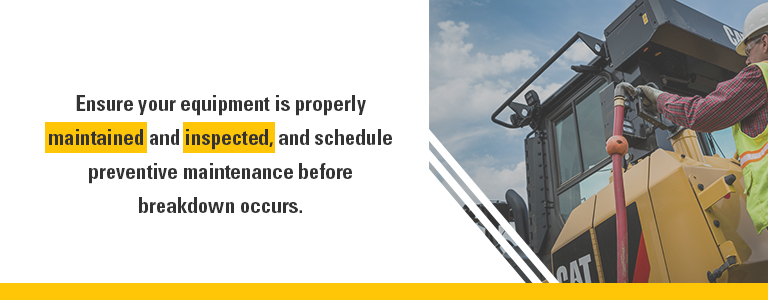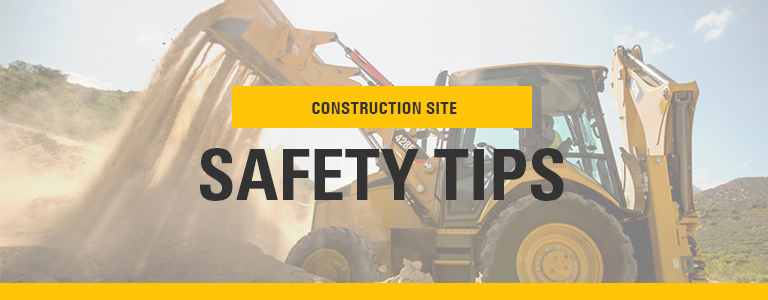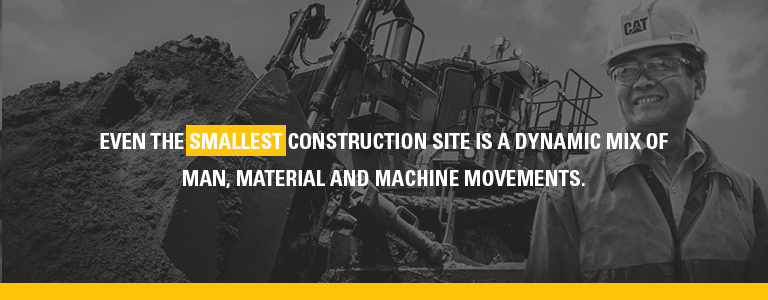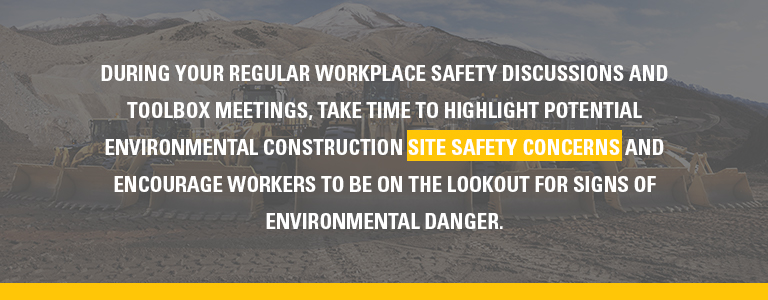The hustle and bustle of a construction site can make it a dangerous place to be. While proper planning, care and safety tips can reduce risks, the inherent nature of construction sites and the amount of equipment, vehicle and human traffic means every member of your crew needs to be vigilant and aware of the dangers. Here at Western States Cat, we’re proud to carry Caterpillar-branded equipment and use our experience to help our customers improve their worksite safety. Take the time to study this guide and put in place any safety practices that are lacking from your site. The benefits are threefold:
- You can avoid costly downtime related to worker and equipment accidents
- You can avoid fines and restrictions for failing to follow OSHA rules and guidelines for construction workers
- Most importantly, your workers get to go home safe after a rewarding day’s work
The government and OSHA are constantly reviewing construction site accident data and worker deaths as they continually pinpoint areas for improvement. Make sure you have a culture of safety in place on your worksites and you are following all proper safety guidelines in terms of equipment movement and traffic, worker personal protective equipment (PPE), risk assessment, hazard identification, environmental risks and more.
Troubling Statistics for Construction Sites
Even the smallest construction site is a dynamic mix of man, material and machine movements. These all need to be coordinated carefully to avoid collisions, entrapment, falls, cave-ins and other dangerous situations. With over 6 million Americans working on over a quarter of a million jobsites every day, construction research shows an alarming number of accidents that lead to injury, lost time and even death. OSHA works continuously to find new ways to guide construction site planners and help them avoid accidents. Some of the most common construction workplace accidents include:
- Falls from height
- Electric shock/electrocution
- Trench and scaffolding collapses
- Vehicular accidents
- Failure to wear proper PPE
While safe work zone practices and construction site safety rules need to be in place and enforced, workers also need to be empowered to raise their voice if they encounter unsafe work practices. Maintain an open dialogue with your managers, supervisors and workers and constantly remind them that safety is never an afterthought. Stress the serious consequences of heavy equipment-related accidents, because an accident with a loader, dozer or other large piece of machinery can lead to serious injury or death.
We have identified three major elements you can review in relation to your construction site:
- General Construction site safety
- Environmental construction site safety
- Equipment construction site safety training
Focusing on these three areas to improve the safety of your construction site can dramatically lower heavy equipment-related incidents, construction worker deaths, job-related injuries and costly downtime due to accident investigation and reporting.
General Construction Site Safety
If you take the time to think about it, almost all workplace accidents are predictable. When proper safety guidelines are followed, there is no reason for a worker to go home injured or, worse, not go home at all. Consider these common site accidents and safety issues:
Equipment failure: Broken machinery and equipment can lead to workplace accidents. A broken chain, busted hydraulic line or improperly secured load can cause construction material to fall or collapse. Ensure your equipment is properly maintained and inspected, and schedule preventive maintenance before breakdown occurs.
- Improper equipment usage: Never use a machine beyond its weight, load or reach limits. Follow all guidelines and choose the right tool for the job. The extra time it takes to bring in a new piece of equipment is worth it if you avoid causing a serious accident. Frequent training sessions for specific equipment can help operators understand the limits.
- Falls: A simple fall from any height can have devastating consequences. Every day in the U.S., workers are injured due to a fall. This includes falls off platforms, buildings, equipment, ledges and aerial work platforms. Insist on proper harnessing for all work at elevated heights and verify fall protection systems are in use.
- Collapses: Failure to properly erect scaffolding or security barriers for trenching is another common cause of construction site injury and death. Discard or repair damaged scaffolding and perform a safety check of all scaffolding, structures, barriers and trench forms before workers enter these zones.
- Electrical shock: Electrical shock (or electrocution, when fatal) is often a result of a careless approach to equipment wiring and repair. Never bypass electrical safety switches and always respect electrical load limits. Provide workers with the tools and PPE necessary to work safely with electrical equipment.
- Heavy equipment accidents: While manufacturers like Caterpillar do their best to give operators adequate visibility and sightlines, the sheer size of heavy construction equipment makes accidents a real site risk. Train your operators and foot workers alike to respect site traffic rules and always wait for visual contact in order to move construction equipment safety.
- Failure to wear PPE: Unfortunately, a large number of accidents in the construction industry are because workers failed to wear the necessary PPE. Enforce a zero tolerance rule for safety equipment (boots, hardhats, glasses, gloves, high-visibility clothing, etc.) and promote a culture of PPE to enforce construction site safety.
While this list covers many of the heavy equipment and construction worker safety risks, it is not complete. Every construction site has a unique set of conditions, equipment and workers that requires a unique approach to safety. Proper planning before workers ever set foot on your site is the best way to avoid accidents, and continuous improvement helps your safety culture evolve as your construction job progresses.
Invite your workers to submit their own construction safety ideas and tips and make them part of the solution to workplace injuries and heavy equipment-related incidents. Make them aware of the National Safety Stand Down movement, where workers and employers take a break from what they are doing to discuss hazards and prevention. A stand-down talk doesn’t have to take long; it simply brings everyone on your site together to have a serious discussion about hazards on construction sites and how to best avoid them. Encourage workers to talk about accidents they have had, accidents they have heard of, near-miss accidents and positive examples where safety equipment and safe work practices helped them avoid an accident.
Environmental Construction Site Safety
While many construction site safety concerns are relatively easy to identify, other environmental construction site safety issues aren’t. Workers need to be aware that they can have an impact on the environment around them in terms of pollution, damage to vegetation and waterways, and noise and cleanliness concerns, the environment can also impact the safety of a construction site. Heavy construction equipment may respond differently in certain environmental conditions, so make sure operators are aware of seasonal differences in terrain, stability, traction, etc.
Long-term projects — such as roadway, bridge and building projects — are susceptible to changes in environmental conditions, whether they’re related to the climate, ground shifting, seasonal changes, etc.. During your regular workplace safety discussions and toolbox meetings, take time to highlight potential environmental construction site safety concerns and encourage workers to be on the lookout for signs of environmental danger.
Some common points of concern include:
- Working in inclement weather, such as high winds, heavy rain or snow/ice conditions
- Flow and erosion concerns when working in the vicinity of waterways and drainage canals
- Shifting or crumbling earth, especially when trenching or digging for foundations and footings
- Risks related to working near natural gas, oil, sewage and other pipelines susceptible to spills
If you are unaware of the extent of environmental concerns with respect to the safety of your construction site, contact local, state and federal experts in construction safety. Request an environmental safety inspection of your site and include recommendations in your regular construction site safety procedures. Including these environmental factors in your day-to-day safety routine helps further foster a culture of safety at your construction site and helps your workers understand they are key players in their own safety and accident avoidance.
Equipment Construction Site Safety Training
Training needs to be continual, with refresher courses to keep workers aware of dangers and training to account for new risks related to additional equipment, construction site layout changes, safety rules and regulations updates, and more. Using heavy equipment in certain environmental conditions also carries its own concerns, so it is important to teach your workers and equipment operators to recognize this.
During meetings, add in a short safety session to discuss accidents, near misses and successes from the day before. Remind workers that a near-miss accident is a valuable tool and can help keep the problem from reoccurring. Formalize your training so all employees receive the same rules, guidelines and context. Encourage senior members of your crews to take on a safety leadership role and train new employees on potential dangers of a worksite. Simple rules like waiting to make visual contact with a heavy equipment operator before crossing their work zone can reduce vehicle-related accidents dramatically. Also, empower your workers to look out for others and watch for potential accidents all around them, not just in front of their nose.
While the primary concern on a construction site in terms of safety is the prevention of human injury and death, it is useful to express the cost of incidents and accidents in terms of downtime, lost income and government fines as well. Your workers count on their job to feed their families, and a lax approach to safety can put a construction site in jeopardy. Carelessness can lead to personal injury, as well as damage to equipment, property and the reputation of your business, which can all have a severe economic effect. Pushing equipment beyond its safe operating conditions — overloading, extending/reaching too far, operating on uneven terrain, etc. — is a recipe for disaster, so make sure operators know the limits of their equipment and stay within safe working parameters.
Where Western States Cat Can Help
Only you can fully assess the risk factors at your construction site and enact rules and guidelines that ensure worker safety. Our team here at Western States Cat is happy to share our experience as it relates to equipment safety. We can help you understand the risk factors associated with your construction heavy equipment and explain the importance of regular inspection and maintenance.
Western States Cat is also your source for quality new and used Cat equipment, machines and attachments. Choosing the right equipment for your job will have a positive effect on your workplace safety and can help eliminate equipment-related risks.
Construction site safety doesn’t happen by accident, so put heavy equipment technology to good use and make sure you stay on track, on budget and on top of worker safety at your site.



